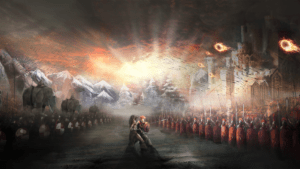Introduction
Since the crucifixion of Jesus, opponents of Christianity have directly criticized the religion’s foundation, attempting to belie the historicity of Christ’s physical resurrection. Aiming to nullify Christianity and confute the prospect of supernatural intervention or divine involvement, skeptics and opponents of Christianity continually disseminate naturalistic alternatives, or conspiracy theories, to contradict the resurrection account. A popular alternative reasons against the validity of eyewitness accounts, suggesting that post-crucifixion appearances of Jesus were merely hallucinations, temporarily experienced by some of Jesus’ early disciples. This paper will examine the hallucination hypothesis, highlighting inconsistencies within this argument, while demonstrating its inability to account for the historical evidence.
Hallucinations Are Individual Experiences
The foundation for this investigation lies within the clinical definition of “hallucination,” which describes the phenomena as a “perception-like experience with the clarity and impact of a true perception but without the external stimulation of the relevant sensory organ. Hallucinations should be distinguished from illusions, in which an actual external stimulus is misperceived or misinterpreted.”1 Hallucinations therefore, are subjective events by definition, as an individual sensory malfunction temporarily produces an event inconsistent with reality, and absent of external stimulus. The biblical account records twelve separate post-mortem appearances of Jesus, nine of which occurred in a group of two or more individuals.2 These group interactions provide direct evidence against the concept of a subjective experience.
However, these biblical accounts, detailing Jesus’ post-crucifixion appearance to groups of people, fail to dissuade proponents of the hallucination hypothesis. Advocates, such as Dr. Keith M. Parsons (Associate Professor of Philosophy, University of Houston, Clear Lake), contend the groups suffered a “mass” (or “collective”) hallucination, asserting that hallucinations are not always isolated, and “mass hallucinations are extremely well documented.”3 This argument is problematic in multiple respects. First, Parsons fails to provide empirical data and/or results from clinical experimentation, to validate his claims. Contrarily, Dr. Gary A. Sibcy (an expert in the field of clinical psychology) comments,
I have surveyed the professional literature (peer-reviewed journal articles and books) written by psychologists, psychiatrists, and other relevant healthcare professionals during the past two decades and have yet to find a single documented case of a group hallucination, that is, an event for which more than one person purportedly shared in a visual or other sensory perception where there was clearly no external referent.4
Rather than appealing to clinical studies, Parsons’s contention centers upon modern reports of unexplained phenomena, suggesting, “large numbers of people, far more than 500, have witnessed UFO’s on given occasions.”5 This vague, generalized statement appears to incite ridicule of the eyewitnesses—grouping them with Sci-Fi fanatics—rather than provide an adequate basis for correlation or comparison. Should a group of 500 people observe an unidentified flying object (UFO), the unidentified object (be it a weather balloon, comet, etc.) is an external stimulus, consistent with reality, which is the antithesis of a hallucination. While speculation concerning identification of the object may cause disagreement, arbitrarily dismissing the event as a hallucination is illogical. Furthermore, the biblical account specifies close, personal interactions with Jesus, allowing eyewitnesses to make a proper identification, and provides no indication that question or dispute arose over the identification of Jesus. As such, Parsons’s assertion fails to provide additional support for the hallucination hypothesis.
Furthermore, the concept of a mass/collective hallucination is inherently contradictory to the medical definition of hallucination, describing the phenomena as a fundamentally subjective experience, invoking spontaneous activation of internal sensory organs and cognitive mechanisms, without external stimulus. An event cannot be both objective (a sensible experience, independent of individual thought, and perceptible by all observers) and subjective (an experience conditioned by personal mental characteristics, lacking in reality or substance) at the same time, and in the same respect.6 Dr. Gary R. Collins (clinical psychologist and distinguished author) affirms this, stating, “Hallucinations are individual occurrences. By their very nature only one person can see a given hallucination at a time. They certainly are not something which can be seen by a group of people….Since an hallucination exists only in this subjective, personal sense, it is obvious that others cannot witness it.”7 It is unreasonable to suggest a group of people could simultaneous suffer from individual sensory malfunctions, producing an objective event, and the proposition itself runs contrary to the current medical understanding of hallucination phenomena. Therefore, the hallucination hypothesis proves unsuccessful in accounting for group encounters with Jesus after his resurrection.
The Hypothesis Cannot Explain Transformed Lives
Not only have proponents failed to substantiate the possibility of collective hallucinations, the hypothesis remains inadequate in accounting for the transformation of the disciples. The biblical narrative describes a diversity of witnesses, including skeptics (e.g. Thomas), unbelievers (e.g. James), and opponents of Christianity (e.g. Paul), all of whom converted to Christianity following personal encounters with the resurrected Jesus.8 Prior to encountering the resurrected Jesus, Thomas expresses skepticism, saying, “Except I shall see in his hands the print of the nails, and put my finger into the print of the nails, and thrust my hand into his side, I will not believe” (John 20:25). During a successive visitation with the disciples, the biblical narrative records Jesus urging Thomas to touch his hands and side, prompting Thomas to respond, “My Lord and my God” (John 20:26-28). Thomas’s subsequent missionary work throughout Parthia and India, and consequent martyrdom, denote a significant transformation not likely to result from a mere hallucinatory episode.9
Similarly, James’s authorship of a New Testament epistle, his role as a prominent church leader in Jerusalem, and his refusal to renounce Christianity unto death (at the hands of Jewish Sanhedrin) illustrate the transformative power of his encounter with the resurrected Jesus (1 Corinthians 15:7).10 Yet, most significant is the metamorphosis of Paul, who transitions from a vehement opponent of Christianity into one of its most influential leaders, following his post-crucifixion interaction with Jesus. Additionally, other disciples demonstrate a drastic alteration in behavior following post-resurrection interactions with Jesus, transitioning from exhibiting cowardice, disbelief, and hopelessness, to demonstrating bold actions in proclaiming Jesus’ deity and resurrection.11 There is no scientific documentation to suggest hallucinations produce such atypical character changes, especially under the hostile opposition experienced by the disciples. The validity of a hallucination event is unlikely to endure the presentation of opposing evidence, cross-examination, or persecution; yet the disciples maintained their testimony despite substantial persecution, refusing to recant even to avoid execution. The physical resurrection of Jesus provides the best explanation of the evidence, justifying life transformations and the extreme conviction of the disciples, whereas the hallucination hypothesis fails to addresses these points.
The Hallucination Does Not Explain the Empty Tomb
The explanatory scope of the hallucination hypothesis is limited, not only failing to account for the transformation of lives, but also failing to explain the empty tomb (Luke 24:2-4). If the resurrection claims were fallacious, early opponents of Christianity could have produced Jesus’ body, thus eliminating the religious sect in its infancy. However, unable to produce Jesus’ body to refute testimonial evidence, ancient officials employed naturalistic explanations to explain the missing corpse (Matthew 28:12-15). Similarly, proponents of the hallucination hypothesis must conjugate additional hypotheses to account for all the historical evidence, such as the empty tomb.
Exemplifying this point, Gerd Lüdemann (a notable New Testament scholar and proponent of the hallucination hypothesis) contests the historicity of empty tomb accounts, declaring the earliest New Testament writings (the epistles of Paul) do not explicitly mention an empty tomb. Lüdemann predicates his argument on 1 Corinthians 15, stating, “There is no mention of the empty tomb in this text…If he [Paul] had known about the empty tomb, he would certainly have referred to it in order to have an additional argument for the resurrection.”12 However, this argument from silence hardly nullifies the veracity of empty tomb accounts, especially when the text details Jesus’ death and burial as preconditions for his subsequent resurrection (1 Corinthians 15:3-4). N.T. Wright (a prominent New Testament scholar) comments, “The fact that the empty tomb itself, so prominent in the gospel accounts, does not appear to be specifically mentioned in this passage, is not significant; the mention here of ‘buried, then raised’ no more needs to be amplified in that way than one would need to amplify the statement ‘I walked down the street’ with the qualification ‘on my feet.’”13 Attempts to negate the testimony of an empty tomb, demonstrate the explanatory impotence of the hallucination hypothesis, while introducing inconsistencies with the testimonial evidence.
For instance, biblical accounts document the disciples’ skepticism of the empty tomb account, prior to seeing the tomb for themselves (Luke 24:9-12), and an occupied tomb would not explain the alleviation of their disbelief. Given the culture, period, and substantial following of Jesus, one would expect reverence of his burial site, yet proclamation of an empty tomb endured in Jerusalem, were verification was possible. Finally, this theory fails to explain why biblical accounts indicate the early church began meeting on Sunday, correlating with the discovery of the empty tomb, and does not address the missing corpse.14 To obtain acceptance as the best explanation, a proposed hypothesis must be reasonable, while adequately accounting for all the details in the historical narrative (especially the empty tomb), and the hallucination hypothesis fails in both categories.
Typical Causal Factors of Hallucination Are Absent
Unable to account for all the details in the biblical narrative, proponents further fail to provide a reasonable basis for attributing hallucinatory events to individuals claiming visual, auditory, and/or physical interaction with Jesus following his execution and burial. Proponents of the hallucination hypothesis typically predicate hallucination events on unique emotional conditions, and/or the stress/trauma associated with Jesus’ execution. For instance, Keith Parsons writes, “The disciples were very likely to be experiencing a strong sense of rejection, isolation, and depression after the execution of Jesus. It is not at all unlikely that more than one of them experienced vivid hallucinations of Jesus.”15 Unique emotional conditions provide the foundation for the hypothesis because there is no evidence to suggest witnesses exhibited typical causal factors of hallucination (which includes mental maladies, sleep deprivation, alcoholism, alcohol withdrawals, or similar drug-induced conditions). Excluding these factors constrains the hypothesis to nonpsychotic conditions, specifically stress or trauma related conditions, and bereavement-induced disorders.
Trauma- and stressor-related disorders occasionally produce dissociative reactions (i.e. “flashbacks”); however, these episodes are trauma-specific reenactments, which “must be distinguished from illusions, hallucinations, and other perceptual disturbances.”16 Patients suffering from bereavement-induced disorders occasionally “experience hallucinations of the deceased (auditory or visual) in which they temporarily perceive the deceased’s presence (e.g., momentarily seeing the deceased sitting in his or her favorite chair).”17 However, appeals to bereavement disorders, without additional support, fail to explain the complexity and unity of eyewitness reports, arising from a diverse group of people. Moreover, the hypothesis fails to explain why all hallucinatory events, or bereavement-induced symptoms, would simultaneously cease after a forty-day period. Additionally, the hypothesis fails to explain why a resurrected Jesus, in bodily form, would remain the primary subject of each hallucination experience. Proponents of the hypothesis fail to address these important considerations, thus failing to provide a reasonable basis for hallucinatory inception.
However, Nicholas Covington (author of Atheism and Naturalism) contends, “studies have shown that individuals who join cults often have schizotypal tendencies, and that schizotypal personalities…are more prone to hallucinations and ‘anomalous perceptual experiences.’”18 This is a deceptive representation of the referenced experimentations on numerous counts. For example, one study referenced in his argument utilized Christians as a control group in their research of cults and new religious movements (NRMs), concluding, “as predicted, it was found that the NRMs had higher scores on scales measuring positive symptomatology than the Christian and the nonreligious control groups.”19 Moreover, the study linked the incorporation of “odd beliefs” (magical powers, telepathy, and perceptual aberrations) with positive symptoms of psychosis (delusions and hallucinations).20 The variables of this study, therefore, do not correlate with the circumstances of early disciples and thus fail to provide an adequate comparison in support of the argument.
Another study referenced in Covington’s argument sought to examine ecsomatic experiences (also referred to as “out-of-body experiences”), a condition radically dissimilar to the testimonial accounts. The experiment purposed to investigate potential cognitive mechanisms associated with schizotypy by engaging subjects in procedures involving relaxation, sensory limitation, and an imagery task, specifically designed to induce delusions.21 Again, this study provides no applicable correlation to the resurrection event; consequently, experimental conclusions from this study do not provide a proper basis for comparison when analyzing resurrection accounts. Therefore, proponents of the hallucination hypothesis remain unable to provide a rational basis for hallucinatory inception, when typical casual factors are absent from witnesses of Jesus’ resurrection.
Conclusion
By examining the hallucination hypothesis, and conducting comparative analysis pertaining to historical evidence and psychological research conclusions, fundamental flaws within the hallucination hypothesis become evident. While superficially the hypothesis appears convincing, it is inconsistent with historical evidence, is limited in explanatory scope, and its assertions are unsubstantiated by scientific evidence. Therefore, the resurrection account remains the best explanation of the recorded evidence, accounting for every detail of the testimonial accounts, while remaining cogent throughout.
- The American Psychiatric Association, Diagnostic and Statistical Manual of Mental Disorders: Fifth Edition (Washington, DC: American Psychiatric Publishing, 2013), 822.
- John 20:10-18, Matthew 28:1-10, Luke 24:13-35, 1 Corinthians 15:5, Luke 24:26-49, John 21, Matthew 28:16-20, 1 Corinthians 15:6, 1 Corinthians 15:7, Acts 1:4-8, and Acts 9:1-9.
All bible citations are from the King James Version (KJV) unless otherwise stated.
This paper assumes the reliability of the gospel accounts. For a detailed explanation of this position, see Michael R. Licona, The Resurrection of Jesus: A New Historiographical Approach (Illinois: IVP Academic, 2010); Craig L. Blomberg, The Historical Reliability of the Gospels (Illinois: IVP Academic, 2007); and Mark D. Roberts, Can We Trust the Gospels? Investigating the Reliability of Matthew, Mark, Luke, and John (Illinois: Crossway, 2007).
- Keith M. Parsons, “Why I Am Not a Christian (2000),” Internet Infidels, Inc., accessed August 26, 2015, http://infidels.org/library/modern/keith_parsons/whynotchristian.html.
- Quoted in Michael R. Licona, “Were the Resurrection Appearances of Jesus Hallucinations?” North American Mission Board, accessed August 26, 2015, http://www.4truth.net/fourtruthpbjesus.aspx?pageid=8589952863.
- Parsons, “Why I Am Not a Christian (2000).”
- Webster’s Dictionary, “Objective,” Merriam-Webster, Inc., accessed August 26, 2015, http://www.merriam-webster.com/dictionary/objective; Webster’s Dictionary, “Subjective.”
- Quoted in Gary R. Habermas, “Explaining Away Jesus’ Resurrection: Hallucination,” Christian Research Institute, accessed August 26, 2015, http://www.equip.org/article/explaining-away-jesus-resurrection-hallucination/.
- John 20:24-25 records the skepticism of Thomas, while Luke 24:9-12 and Luke 24:36-43 records the skepticism of the apostles upon hearing the report of the empty tomb and seeing the resurrected Jesus. John 7:1-5, and Mark 3:20-21 indicate James and Jude, Jesus’ half-brothers, did not believe Jesus was the promised Messiah. Acts 9 denotes Paul’s zealous opposition of Christianity.
- John Foxe, Fox’s Book of Martyrs (California: Star Publishing LLC, 2012), chap. 1, sec. XIII, Adobe PDF e-book.
- Flavius Josephus, The New Complete Works of Josephus, trans. William Whiston (Michigan: Kregel Publications, 1999), 656.
- Matthew 26:56, Mark 14:50, John 20:19, John 20:24-25, and Luke 24:20-21, detail the demeanor of the disciples immediately following Jesus’ crucifixion. Acts 2, and Acts 4:2, record bold actions of the disciples following post-resurrection appearances.
- Quoted in Paul Copan and Ronald K. Tacelli, Jesus’ Resurrection: Fact or Figment? A Debate Between William Lane Craig & Gerd Lüdemann (Illinois: IVP Academic, 2000), 44.
- N.T. Wright, The Resurrection of the Son of God: Christian Origins and the Question of God, Volume 3 (Minnesota: Fortress Press, 2003), Locations 7351-7354, Kindle edition.
- Acts 20:7, and 1 Corinthians 16:1-2, indicate the early church began meeting on Sunday, corresponding with the discovery of the empty tomb, as described in Mark 16:1-7. This is in stark contrast to orthodox Judaism, which specified Saturday as the Sabbath. Matthew 28:12-15 records the missing corpse.
- Parsons, “Why I Am Not a Christian (2000).”
- The American Psychiatric Association, Diagnostic and Statistical Manual of Mental Disorders: Fifth Edition,279.
- Ibid., 791.
- Nick Covington, “Was Jesus Raised from the Dead?: A Response to William Lane Craig's Resurrection Argument,” Internet Infidels, Inc., accessed August 26, 2015, http://infidels.org/kiosk/article/was-jesus-raised-from-the-dead-a-response-to-william-lane-craigs-resurrection-argument-796.html.
- Samantha Day and Emmanuelle Peters, “The Incidence of Schizotypy in New Religious Movements,” Personality and Individual Differences 27, (1999): 63.
- Ibid.
- Charles McCreery and Gordon Claridge, “A Study of Hallucination in Normal Subjects-I. Self-Report Data,” Personality and Individual Differences 21, no. 5 (1996): 740.




